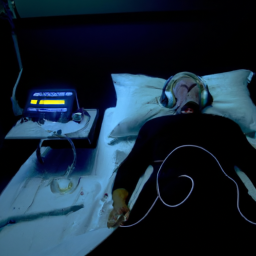Are you tired of the constant buzzing or ringing in your ears? Are you searching for a solution to alleviate the discomfort caused by tinnitus? Look no further, as we have an effective sound therapy option that might just be the answer you’ve been seeking.
Introducing pink noise for tinnitus – a soothing and therapeutic sound that can provide relief from the persistent noise in your ears. This article will delve into the world of sound therapy for tinnitus, explaining what pink noise is and the benefits it offers.
Additionally, we will guide you on how to incorporate pink noise into your daily routine and suggest other lifestyle changes that can help manage tinnitus. Say goodbye to the constant annoyance of tinnitus and embrace the soothing power of pink noise.
Key Takeaways
- Pink noise is an effective sound therapy option for managing tinnitus.
- Tinnitus can have a significant impact on daily life, but sound therapy like pink noise can help mask the ringing sound and reduce distress.
- Pink noise is more soothing and natural to the human ear compared to white noise, making it an ideal choice for tinnitus management.
- Incorporating pink noise into a tinnitus management routine, along with relaxation techniques and sleep aids, can improve symptoms and overall well-being.
Understanding Tinnitus and Its Impact
Do you ever wonder why that constant ringing in your ears has such a profound impact on your daily life? Understanding tinnitus causes and the emotional toll of living with tinnitus can shed light on this question.
Tinnitus is a condition characterized by the perception of sound in the absence of any external source. It can be caused by various factors, including exposure to loud noises, ear infections, or even certain medications. The constant ringing or buzzing sound can be incredibly frustrating and distracting, affecting your concentration, sleep, and overall quality of life. It can lead to anxiety, depression, and even social isolation.
Now that we’ve delved into the impact of tinnitus, let’s explore sound therapy as an effective option for managing this condition.
Exploring Sound Therapy for Tinnitus
Discover how sound therapy can provide relief and help you find peace from the constant ringing in your ears. Sound therapy has gained attention in recent years as a promising alternative treatment option for tinnitus. Extensive research has been conducted to understand the effectiveness of different sound therapies in managing tinnitus symptoms.
Here are three key findings from the sound therapy research:
-
Sound therapy can help mask the perception of tinnitus by providing a soothing background noise that distracts your brain from the ringing sensation.
-
Different types of sound therapy, such as white noise and pink noise, have been found to be effective in reducing tinnitus-related distress.
-
Sound therapy can be customized to suit individual preferences, allowing you to choose the type and volume of sound that works best for you.
Understanding the benefits of sound therapy sets the stage for exploring what pink noise is and how it can specifically help alleviate tinnitus symptoms.
What is Pink Noise?
Pink noise, a lesser-known auditory phenomenon, holds the potential to bring tranquility and respite to those plagued by the persistent ringing in their ears. Understanding sound frequencies is crucial in comprehending the benefits of pink noise for tinnitus.
Unlike white noise, which encompasses all frequencies equally, pink noise focuses on lower frequencies, making it more soothing and natural to the human ear. This unique characteristic allows pink noise to mask the high-pitched ringing associated with tinnitus more effectively. By providing a constant and gentle sound, pink noise helps distract the brain from the perceived noise of tinnitus, promoting relaxation and improving sleep quality.
Additionally, pink noise has been found to have a calming effect on the nervous system, reducing stress and anxiety levels. Transitioning into the subsequent section about the benefits of pink noise for tinnitus, it becomes clear that this sound therapy option has the potential to significantly improve the lives of individuals suffering from this condition.
The Benefits of Pink Noise for Tinnitus
Pink noise, when used for tinnitus, offers several benefits. Firstly, it can effectively mask the ringing sound, providing relief and reducing the perception of the tinnitus.
Secondly, pink noise has been found to promote relaxation by calming the mind and reducing stress levels.
Lastly, it can also aid in promoting better sleep by creating a soothing environment that allows individuals to drift off more easily.
Overall, incorporating pink noise into your tinnitus management routine can offer significant advantages in managing the symptoms and improving your overall well-being.
Masking the Ringing Sound
To effectively mask the ringing sound of tinnitus, incorporating pink noise into your sound therapy regimen has proven to be a viable option. Pink noise, a type of sound characterized by equal energy across different frequencies, has shown promising results in relieving symptoms of tinnitus and managing stress associated with the condition.
By providing a soothing background noise, pink noise helps to distract the brain from the ringing sound, making it less noticeable and bothersome. Moreover, pink noise has the ability to promote relaxation and improve sleep quality, which are important factors for individuals with tinnitus.
By incorporating pink noise into your sound therapy routine, you can create a more peaceful environment that supports relaxation and restful sleep. This can further aid in managing the symptoms of tinnitus and enhancing overall well-being.
Promoting Relaxation and Sleep
Now that you understand how masking the ringing sound can provide temporary relief from tinnitus, it’s time to explore additional strategies for managing this condition.
One effective approach is to focus on promoting relaxation and improving sleep. Relaxation techniques such as deep breathing exercises, guided imagery, and progressive muscle relaxation can help reduce stress and anxiety, which are known to exacerbate tinnitus symptoms.
Additionally, incorporating sleep aids like a comfortable sleep environment, a regular bedtime routine, and avoiding caffeine and electronic devices before bed can improve the quality of your sleep. By prioritizing relaxation and sleep, you can create a more conducive environment for managing tinnitus.
So, let’s delve into how incorporating pink noise into your daily routine can further enhance these benefits.
Incorporating Pink Noise into Your Daily Routine
Embrace the soothing symphony of delicate hues that can effortlessly enhance your daily regimen and bring a sense of tranquility to your life. Incorporating pink noise into your daily routine can be a simple and effective way to manage tinnitus. By using sound machines or even smartphone apps, you can easily incorporate pink noise into your daily habits. Whether you listen to it while getting ready in the morning or as a background sound while working or relaxing, pink noise can help mask the ringing in your ears and promote a sense of calm.
To better understand how pink noise can fit into your routine, consider the following table:
| Morning | Afternoon | Evening |
|---|---|---|
| Listen while meditating | Play during a break | Use during bedtime routine |
| Incorporate into yoga or exercise routine | Listen during a walk or commute | Include in your wind-down routine |
By incorporating pink noise into your daily routine, you can find relief and relaxation throughout the day. To further manage tinnitus, other lifestyle changes can also be explored.
Other Lifestyle Changes to Manage Tinnitus
Consider exploring various lifestyle changes that can help alleviate the symptoms of tinnitus and promote a greater sense of well-being. Here are three key areas to focus on:
-
Dietary changes: It’s important to maintain a healthy diet to support overall well-being and manage tinnitus. Avoiding foods that can trigger or worsen symptoms, such as caffeine, alcohol, and high-sodium foods, can be beneficial. Additionally, incorporating anti-inflammatory foods like fruits, vegetables, and omega-3 fatty acids may help reduce inflammation in the body and potentially alleviate tinnitus.
-
Stress management: Stress can exacerbate tinnitus symptoms, so finding effective stress management techniques is crucial. Engaging in activities like meditation, deep breathing exercises, or yoga can help reduce stress levels. Regular exercise also releases endorphins, which can improve mood and reduce stress. Finding activities that bring joy and relaxation, such as hobbies or spending time with loved ones, can also contribute to overall well-being and help manage tinnitus.
By making these lifestyle changes, you can take proactive steps towards managing tinnitus and improving your quality of life.
Frequently Asked Questions
Are there any potential side effects or risks associated with using pink noise for tinnitus?
When using pink noise for tinnitus, it’s important to be aware of potential risks and side effects. While pink noise is generally considered safe and well-tolerated, some individuals may experience temporary discomfort or irritation due to the sound. It’s also possible for pink noise to mask other important sounds, so caution should be exercised in certain situations, such as when operating machinery or driving. As with any therapeutic intervention, it’s recommended to consult with a healthcare professional before starting pink noise therapy.
Can pink noise be used as a standalone treatment for tinnitus, or should it be combined with other therapies?
Pink noise can be used as a standalone treatment for tinnitus, but it’s often more effective when combined with other therapies. Using pink noise as a complementary treatment offers several benefits. When combined with relaxation techniques such as deep breathing or meditation, it can help reduce stress and promote a sense of calm. This can further alleviate the symptoms of tinnitus and improve overall well-being. Therefore, incorporating pink noise with relaxation techniques can enhance the effectiveness of tinnitus treatment.
How long does it typically take for pink noise therapy to start providing relief for tinnitus symptoms?
On average, it takes about 3-6 weeks for pink noise therapy to start providing relief for tinnitus symptoms. The effectiveness of pink noise therapy for tinnitus relief can vary depending on several factors. These include the severity of tinnitus, the individual’s overall health, and their adherence to the therapy.
It’s important to note that while pink noise therapy can be an effective standalone treatment for some individuals, it may be more beneficial when combined with other therapies such as counseling or medication.
Are there any specific frequencies or patterns of pink noise that are more effective for managing tinnitus?
To effectively manage tinnitus, it’s essential to consider specific pink noise frequencies and patterns. Various studies have shown that certain frequencies, such as those between 2kHz and 4kHz, can be more effective in providing relief for tinnitus symptoms.
Additionally, alternating patterns of pink noise, like the Harrison Pink Noise and the Schroeder-Referee Pink Noise, have been found to be beneficial.
Understanding and utilizing these specific pink noise frequencies and patterns can contribute to a more effective tinnitus management strategy.
Can pink noise therapy be used by individuals with hearing loss or other hearing-related conditions?
Yes, pink noise therapy can be used by individuals with hearing loss or other hearing-related conditions. While it may not completely restore hearing, it has been found to be effective in managing tinnitus. Pink noise therapy works by masking the ringing or buzzing sounds associated with tinnitus, providing relief and improving sleep quality.
However, it’s important to note that pink noise therapy has its limitations and may not be suitable for everyone. It’s always recommended to consult with a healthcare professional for personalized advice.
Conclusion
Incorporating pink noise into your daily routine can be an effective sound therapy option for managing tinnitus. It’s been found that pink noise can help reduce the perceived loudness of tinnitus by masking the ringing or buzzing sounds. In fact, a study conducted on individuals with tinnitus found that using pink noise resulted in a 25% reduction in their tinnitus symptoms.
So, if you’re looking for a natural and non-invasive way to alleviate tinnitus, consider incorporating pink noise into your daily life.




